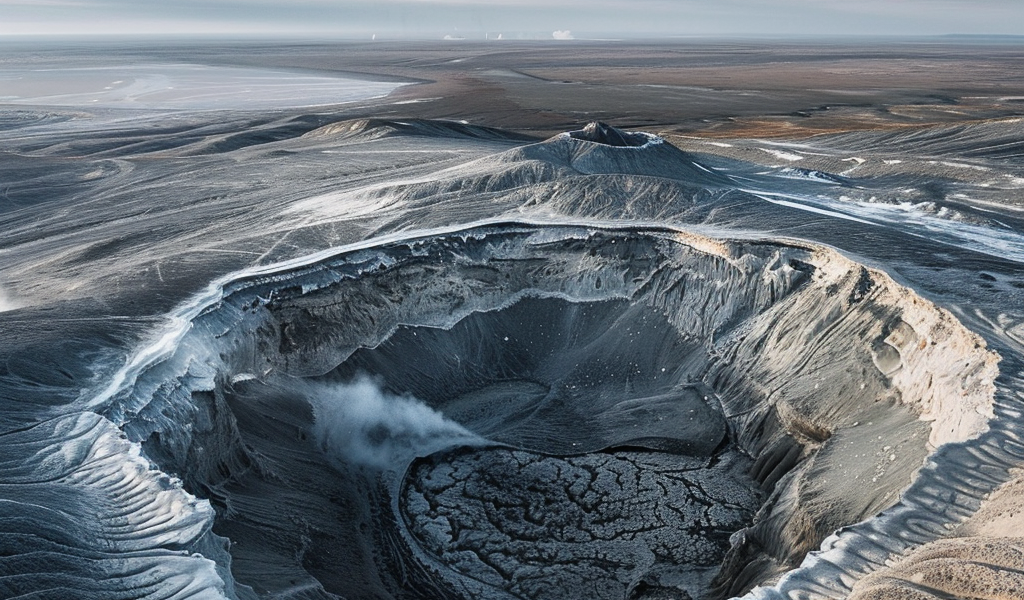In the remote regions of northwestern Siberia, particularly the Yamal and Gydan Peninsulas, a series of mysterious craters have emerged over the past decade, capturing the attention of scientists and the public alike. These explosive formations, some stretching hundreds of feet wide, have raised numerous questions about their origins and the underlying geological processes at play.
The phenomenon first came to light in 2014 when a massive crater appeared, revealing a jagged hole that seemed to plunge into an abyss. Since then, more than 20 similar craters have been discovered, with the latest one identified in August. Their sudden formation has led to a flurry of hypotheses, ranging from the mundane to the bizarre, including theories about meteor strikes and extraterrestrial activity.
Recent research conducted by a multidisciplinary team of engineers, physicists, and computer scientists has shed new light on this geological mystery. Their study, published last month, proposes that the craters’ formation is primarily influenced by human-induced climate change combined with the unique geological characteristics of the region.
Scientists had previously established that these craters are formed when gases, particularly methane, become trapped beneath the tundra. As these gases accumulate, they create pressure that eventually leads to an explosive release. However, the specific details of how this pressure builds and the exact sources of the gas remained unclear.
Ana Morgado, a chemical engineer at the University of Cambridge and one of the authors of the study, likened their investigative approach to that of detectives solving a case. The team initially explored the possibility that the explosions were the result of chemical reactions but quickly dismissed this idea due to a lack of evidence supporting chemical combustion.
Instead, Morgado explained that the process is more akin to “pumping up a tire.” The research team focused on the complex geology of the Siberian landscape, which consists of layers of permafrost, methane hydrates, and pockets of salty, unfrozen water known as cryopegs.
Permafrost, a layer of soil and sediment that remains frozen year-round, sits atop a layer of methane hydrates. These hydrates are solid forms of methane, which can become unstable under certain conditions. Between the permafrost and the methane hydrates lies the cryopeg layer, which is approximately three feet thick and contains salty water that remains unfrozen even in frigid temperatures.
As global temperatures rise due to climate change, the upper layers of permafrost begin to melt. This melting process allows water to seep down into the cryopeg layer, where it mixes with the salt and potentially contributes to the buildup of pressure. The interaction between the melting permafrost and the cryopegs plays a crucial role in the formation of the craters.
The findings from this research highlight the intricate relationship between climate change and geological processes. As temperatures continue to rise, the stability of the permafrost and the methane hydrates could be further compromised, leading to an increased frequency of these explosive events.
In addition to the immediate geological implications, the release of methane—a potent greenhouse gas—during these explosions could have far-reaching consequences for global climate patterns. Methane is significantly more effective at trapping heat in the atmosphere than carbon dioxide, raising concerns about its impact on climate change.
The study underscores the importance of understanding the interplay between human activity and natural processes in the context of climate change. As scientists continue to investigate these craters, they aim to develop a more comprehensive understanding of the mechanisms at work and the potential implications for the Arctic environment.
As researchers delve deeper into the mysteries of these Siberian craters, they are not only uncovering the geological forces that shape our planet but also emphasizing the urgent need for action on climate change. The findings serve as a stark reminder of the interconnectedness of human activity and the natural world, highlighting the potential consequences of our actions on the environment.
With ongoing studies and monitoring of these phenomena, scientists hope to gain further insights into the dynamics of the Arctic landscape and the broader implications for our planet’s climate system.
As the world grapples with the challenges posed by climate change, the story of these craters serves as a compelling example of how our understanding of the Earth is continually evolving. The research not only provides answers to long-standing questions but also raises new ones, ensuring that the dialogue around climate change and its effects on our planet remains at the forefront of scientific inquiry.





